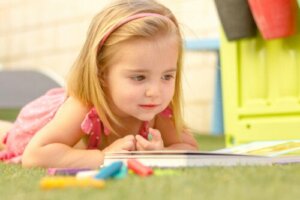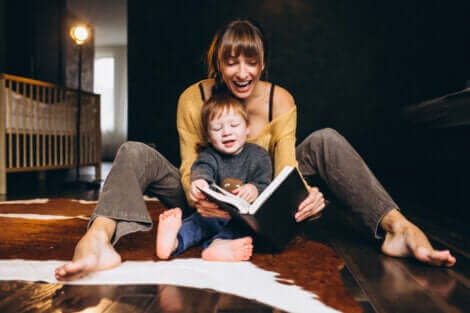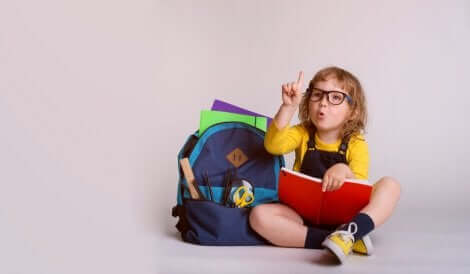5 Stories to Learn to Add

Children’s books are a wonderful tool to help little ones learn basic knowledge that will lay the foundation for their education. Mathematics, and more specifically numbers, are one of the first things kids learn in the classroom, since they’re a part of people’s lives on a daily basis. Here, we’ll show you stories to help kids learn to add.
To make this learning more dynamic and fun for children, leaving behind the old ways of learning to add, the different new methods make this activity much easier. Therefore, in this article, you’ll find a selection of stories where adults and kids will learn and have fun together.
Stories to learn to add
1. The Very Hungry Caterpillar
This book has very striking colors and illustrations for little ones, who will be able to add the foods that the caterpillar in the story is eating. At the same time, they see them with the die-cut illustrations.
In addition, with this fantastic book, they’ll learn first-hand about the growth, change or metamorphosis that this animal undergoes throughout his life cycle until he becomes a butterfly.
This book has been so successful that it’s already been published in numerous formats so that the smallest children choose the one that catches their eye the most. It’s certainly a classic children’s book to learn to add.

2. Adding and Subtracting Activity Book
From Usborne publishing house, the little ones will learn two of the four basic mathematical operations: addition and subtraction. Through autonomous learning, and without even realizing it, they’ll be able to add and subtract in an easy and simple way.
This workbook includes an erasable marker so that kids can practice these operations as many times as they want. The structure to do the addition looks fun for kids: some illustrations are included on each page with questions. These questions refer to the number to include for the sum.
For example: how many windows does the ice cream truck have? The child will have to look at the picture and count the windows they see. In addition to learning to add, children will also practice attention and observation.
3. Count to 100
Recommended for children from three years old, with this fantastic colorful and eye-catching book, the little ones will learn to count to 100 and learn to add simple operations.
The pictures are fantastic and will show children many objects and animals that will fascinate them. However, in these pages, they won’t just learn to count to 100 and add things, but also to make groups by the way they are arranged. Therefore, they learn to relate quantities with how they’re written.
Also, just like the previous book, this book is great for staying focused and paying attention, as well as continuous observations while reading.

4. One, Five, Many
This is one of the best picture books with a multitude of educational activities for children to learn numbers and the basic operations of addition and subtraction.
Designed by a Czech illustrator, children will find transparencies, flaps and die-cut illustrations on its pages, all referring to the world of numbers. It’s a different way for children to have fun and learn at the same time.
5. Cinderella’s 10 Shoes, one of the funniest stories to learn to add
One of the best-known classic stories in children’s literature, Cinderella, is converted into a fantastic book about numbers for little ones to learn.
As a game, it includes concepts related to the world of mathematics. For example, it has the basic operations of addition and subtraction, as well as the difference between cardinal and ordinal numbers.
Recommended for children from four years old, this book also includes activities and games related to the story of Cinderella. Kids can practice math without even realizing it because they’re having so much fun.
Children’s books are a wonderful tool to help little ones learn basic knowledge that will lay the foundation for their education. Mathematics, and more specifically numbers, are one of the first things kids learn in the classroom, since they’re a part of people’s lives on a daily basis. Here, we’ll show you stories to help kids learn to add.
To make this learning more dynamic and fun for children, leaving behind the old ways of learning to add, the different new methods make this activity much easier. Therefore, in this article, you’ll find a selection of stories where adults and kids will learn and have fun together.
Stories to learn to add
1. The Very Hungry Caterpillar
This book has very striking colors and illustrations for little ones, who will be able to add the foods that the caterpillar in the story is eating. At the same time, they see them with the die-cut illustrations.
In addition, with this fantastic book, they’ll learn first-hand about the growth, change or metamorphosis that this animal undergoes throughout his life cycle until he becomes a butterfly.
This book has been so successful that it’s already been published in numerous formats so that the smallest children choose the one that catches their eye the most. It’s certainly a classic children’s book to learn to add.

2. Adding and Subtracting Activity Book
From Usborne publishing house, the little ones will learn two of the four basic mathematical operations: addition and subtraction. Through autonomous learning, and without even realizing it, they’ll be able to add and subtract in an easy and simple way.
This workbook includes an erasable marker so that kids can practice these operations as many times as they want. The structure to do the addition looks fun for kids: some illustrations are included on each page with questions. These questions refer to the number to include for the sum.
For example: how many windows does the ice cream truck have? The child will have to look at the picture and count the windows they see. In addition to learning to add, children will also practice attention and observation.
3. Count to 100
Recommended for children from three years old, with this fantastic colorful and eye-catching book, the little ones will learn to count to 100 and learn to add simple operations.
The pictures are fantastic and will show children many objects and animals that will fascinate them. However, in these pages, they won’t just learn to count to 100 and add things, but also to make groups by the way they are arranged. Therefore, they learn to relate quantities with how they’re written.
Also, just like the previous book, this book is great for staying focused and paying attention, as well as continuous observations while reading.

4. One, Five, Many
This is one of the best picture books with a multitude of educational activities for children to learn numbers and the basic operations of addition and subtraction.
Designed by a Czech illustrator, children will find transparencies, flaps and die-cut illustrations on its pages, all referring to the world of numbers. It’s a different way for children to have fun and learn at the same time.
5. Cinderella’s 10 Shoes, one of the funniest stories to learn to add
One of the best-known classic stories in children’s literature, Cinderella, is converted into a fantastic book about numbers for little ones to learn.
As a game, it includes concepts related to the world of mathematics. For example, it has the basic operations of addition and subtraction, as well as the difference between cardinal and ordinal numbers.
Recommended for children from four years old, this book also includes activities and games related to the story of Cinderella. Kids can practice math without even realizing it because they’re having so much fun.
All cited sources were thoroughly reviewed by our team to ensure their quality, reliability, currency, and validity. The bibliography of this article was considered reliable and of academic or scientific accuracy.
- Anno Mitsumasa. (2004). Las semillas mágicas. Fondo de Cultura Económica.
- Brooks, F. (2017). Cuenta hasta 100. Usborne.
- Carle, E. (2009). La pequeña oruga glotona. Editorial Kokinos.
- Gañán Barrios, N. (2015). La aplicación de los cuentos para el aprendizaje lógico matemático. Disponible en: http://uvadoc.uva.es/handle/10324/14574
- Gehm Franziska y Rachner Marina. (2016). 10 ovejitas. Editorial Urano.
- Pacovska, K. (2010). Uno, cinco, muchos. Editorial Kokinos.
- Pérez, M. (2016). Los 10 zapatos de Cenicienta. BEASCOA.
- Vvaa. (2013). Aprendo a sumar y a restar. Usborne.
This text is provided for informational purposes only and does not replace consultation with a professional. If in doubt, consult your specialist.








